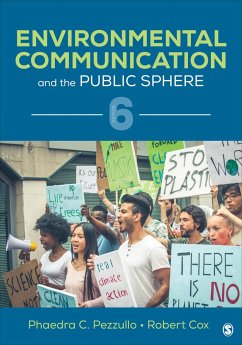- Broschiertes Buch
- Merkliste
- Auf die Merkliste
- Bewerten Bewerten
- Teilen
- Produkt teilen
- Produkterinnerung
- Produkterinnerung
The best-selling Environmental Communication and the Public Sphere provides a comprehensive introduction to the growing field of environmental communication. This groundbreaking book focuses on the role that human communication plays in influencing the ways we perceive the environment. Authors Phaedra C. Pezzullo and Robert Cox examine how we define what constitutes an environmental problem and how we decide what actions to take concerning the natural world. The Sixth Edition explores recent events and research, including fast fashion, global youth climate strikes, biodiversity loss,…mehr
Andere Kunden interessierten sich auch für
![Trager′s the Law of Journalism and Mass Communication Trager′s the Law of Journalism and Mass Communication]() Victoria Smith EkstrandTrager′s the Law of Journalism and Mass Communication135,99 €
Victoria Smith EkstrandTrager′s the Law of Journalism and Mass Communication135,99 €![Empathy in the Global World Empathy in the Global World]() Carolyn Calloway-ThomasEmpathy in the Global World96,99 €
Carolyn Calloway-ThomasEmpathy in the Global World96,99 €![Intercultural Interaction Intercultural Interaction]() H. Spencer-OateyIntercultural Interaction76,99 €
H. Spencer-OateyIntercultural Interaction76,99 €![McQuail's Media and Mass Communication Theory McQuail's Media and Mass Communication Theory]() Denis McQuailMcQuail's Media and Mass Communication Theory41,99 €
Denis McQuailMcQuail's Media and Mass Communication Theory41,99 €![McQuail's Media and Mass Communication Theory McQuail's Media and Mass Communication Theory]() Denis McQuailMcQuail's Media and Mass Communication Theory135,99 €
Denis McQuailMcQuail's Media and Mass Communication Theory135,99 €![Intercultural Interaction Intercultural Interaction]() H. Spencer-OateyIntercultural Interaction76,99 €
H. Spencer-OateyIntercultural Interaction76,99 €![The Digital Disconnect The Digital Disconnect]() Ellen HelsperThe Digital Disconnect98,99 €
Ellen HelsperThe Digital Disconnect98,99 €-
-
-
The best-selling Environmental Communication and the Public Sphere provides a comprehensive introduction to the growing field of environmental communication. This groundbreaking book focuses on the role that human communication plays in influencing the ways we perceive the environment. Authors Phaedra C. Pezzullo and Robert Cox examine how we define what constitutes an environmental problem and how we decide what actions to take concerning the natural world. The Sixth Edition explores recent events and research, including fast fashion, global youth climate strikes, biodiversity loss, disability rights advocacy, single-use plastic ban controversies, and the COVID-19 pandemic.
Produktdetails
- Produktdetails
- Verlag: SAGE Publications, Inc / Sage Publications
- 6. Aufl.
- Seitenzahl: 392
- Erscheinungstermin: 22. Juni 2021
- Englisch
- Abmessung: 254mm x 178mm x 21mm
- Gewicht: 738g
- ISBN-13: 9781544387031
- ISBN-10: 1544387032
- Artikelnr.: 61341403
- Herstellerkennzeichnung
- Libri GmbH
- Europaallee 1
- 36244 Bad Hersfeld
- gpsr@libri.de
- Verlag: SAGE Publications, Inc / Sage Publications
- 6. Aufl.
- Seitenzahl: 392
- Erscheinungstermin: 22. Juni 2021
- Englisch
- Abmessung: 254mm x 178mm x 21mm
- Gewicht: 738g
- ISBN-13: 9781544387031
- ISBN-10: 1544387032
- Artikelnr.: 61341403
- Herstellerkennzeichnung
- Libri GmbH
- Europaallee 1
- 36244 Bad Hersfeld
- gpsr@libri.de
Phaedra C. Pezzullo is Associate Professor at the University of Colorado Boulder, and a dual citizen with the US and Italia. Her interdisciplinary background informs her research on environmental justice, climate justice, just transition, public advocacy, and tourist studies. Her book, Toxic Tourism (University of Alabama Press, 2007), won four awards, including the Jane Jacobs Urban Communication Book Award and the National Communication Association's Environmental Communication Division Book Award. Among other publications, she coedited Green Communication and China (Michigan State University Press, 2020) and Environmental Justice and Environmentalism (MIT Press, 2007). She was a founding editor of the journal Environmental Communication and serves on its editorial board. She has volunteered on the Sierra Club's national Environmental Justice Committee and Affinity Group Working Group, consulted with cities and counties on a just transition, and was a delegate at COP21 in Paris. Pezzullo is a founding co-director of the Center for Creative Climate Communication and Behavior Change (C3BC) on her campus. She also enjoys outdoor recreation and cooking a plant-based diet.
Preface to the Sixth Edition
Introduction: Speaking for/About the Environment
About the Authors
Part I: Communicating for/About the Environment
Chapter 1: Defining Environmental Communication
Studying Environmental Communication
Communication, the Environment, and the Public Sphere
Diverse Environmental Voices in the Public Sphere
Summary
Suggested Resources
Key Terms
Discussion Questions
Chapter 2: Contested Meanings: A Brief History
Turtle Island
Learning to Love Nature
Wilderness Preservation Versus Natural Resource Conservation
Public Health and the Ecology Movement
Environmental Justice: Linking Social Justice and Public Health
Contemporary Movements for Sustainability and Climate Justice
Summary
Suggested Resources
Key Terms
Discussion Questions
Chapter 3: Symbolic Constructions of the Environment
A Rhetorical Perspective
Dominant and Critical Discourses
Summary
Suggested Resources
Key Terms
Discussion Questions
Chapter 4: Environmental Media and Sustainability
The Environment and Popular Culture
Sustainability: An Interdisciplinary Approach
Sustainability Discourses
Corporate Sustainability Communication: Reflection or Deflection?
Greenwashing
Summary
Suggested Resources
Key Terms
Discussion Questions
Part II: Environmental Campaigns and Movements
Chapter 5: Environmental Advocacy Campaigns
Environmental Advocacy
Environmental Advocacy Campaigns
The Campaign to Protect Zuni Salt Lake
Summary
Suggested Resources
Key Terms
Discussion Questions
Chapter 6: Digital Environmental Organizing
Grassroots Activism and Digital Media
Environmental NGOs and Digital Campaign Dilemmas
Multimodality and Networked Campaigns
Summary
Suggested Resources
Key Terms
Discussion Questions
Chapter 7: Visual and Market Advocacy
Visual Rhetoric and Nature Advocacy
Moving Images of Disasters
Summary
Suggested Resources
Key Terms
Discussion Questions
Chapter 8: Environmental Justice and Climate Justice Movements
Environmental Justice: Challenges, Critiques, and Change
Honoring Frontline Knowledge and Traveling on Toxic Tours
The Global Movement for Climate Justice
Summary
Suggested Resources
Key Terms
Discussion Questions
Part III: Environmental Discourses and Public Spheres
Chapter 9: Environmental Journalism
Environmental Journalism in the Public Sphere
Breaking News and Environmental Journalism
Media Effects and Influences
Digital Storytelling and Environmental News
Summary
Suggested Resources
Key Terms
Discussion Questions
Chapter 10: Science and Climate Communication
Scientific Argumentation
Early Warners: Environmental Scientists and the Public
Resisting (Climate) Science
Communicating Climate Science
Summary
Suggested Resources
Key Terms
Discussion Questions
Chapter 11: Public Health and Environmental Risk Communication
Dangerous Environments: Assessment in a Risk Society
Communicating Environmental Risks in the Public Sphere
The Precautionary Principle
Citizens Becoming Scientists
Voices of Environmental Risk
Summary
Suggested Resources
Key Terms
Discussion Questions
Part IV: Green Governance and Legal Spheres
Chapter 12: Public Participation and Democratic Rights
Rights of Public Participation
Right to Know: Transparency and Access to Information
Right to Comment: Involvement
SLAPP: Strategic Litigation Against Public Participation
Growth of Public Participation Internationally
Summary
Suggested Resources
Key Terms
Discussion Questions
Chapter 13: Voice and Public Dissent
Right of Expression and Right of Assembly
Right of Standing: Who Legally Can Speak?
Landmark Cases on Environmental Standing
Reversing, Slowing, or Reducing Global Warming as Injury
Who Should Have a Right of Standing?
Summary
Suggested Resources
Key Terms
Discussion Questions
Epilogue: Imagining Stories of/for Our Future
Glossary
References
Index
Introduction: Speaking for/About the Environment
About the Authors
Part I: Communicating for/About the Environment
Chapter 1: Defining Environmental Communication
Studying Environmental Communication
Communication, the Environment, and the Public Sphere
Diverse Environmental Voices in the Public Sphere
Summary
Suggested Resources
Key Terms
Discussion Questions
Chapter 2: Contested Meanings: A Brief History
Turtle Island
Learning to Love Nature
Wilderness Preservation Versus Natural Resource Conservation
Public Health and the Ecology Movement
Environmental Justice: Linking Social Justice and Public Health
Contemporary Movements for Sustainability and Climate Justice
Summary
Suggested Resources
Key Terms
Discussion Questions
Chapter 3: Symbolic Constructions of the Environment
A Rhetorical Perspective
Dominant and Critical Discourses
Summary
Suggested Resources
Key Terms
Discussion Questions
Chapter 4: Environmental Media and Sustainability
The Environment and Popular Culture
Sustainability: An Interdisciplinary Approach
Sustainability Discourses
Corporate Sustainability Communication: Reflection or Deflection?
Greenwashing
Summary
Suggested Resources
Key Terms
Discussion Questions
Part II: Environmental Campaigns and Movements
Chapter 5: Environmental Advocacy Campaigns
Environmental Advocacy
Environmental Advocacy Campaigns
The Campaign to Protect Zuni Salt Lake
Summary
Suggested Resources
Key Terms
Discussion Questions
Chapter 6: Digital Environmental Organizing
Grassroots Activism and Digital Media
Environmental NGOs and Digital Campaign Dilemmas
Multimodality and Networked Campaigns
Summary
Suggested Resources
Key Terms
Discussion Questions
Chapter 7: Visual and Market Advocacy
Visual Rhetoric and Nature Advocacy
Moving Images of Disasters
Summary
Suggested Resources
Key Terms
Discussion Questions
Chapter 8: Environmental Justice and Climate Justice Movements
Environmental Justice: Challenges, Critiques, and Change
Honoring Frontline Knowledge and Traveling on Toxic Tours
The Global Movement for Climate Justice
Summary
Suggested Resources
Key Terms
Discussion Questions
Part III: Environmental Discourses and Public Spheres
Chapter 9: Environmental Journalism
Environmental Journalism in the Public Sphere
Breaking News and Environmental Journalism
Media Effects and Influences
Digital Storytelling and Environmental News
Summary
Suggested Resources
Key Terms
Discussion Questions
Chapter 10: Science and Climate Communication
Scientific Argumentation
Early Warners: Environmental Scientists and the Public
Resisting (Climate) Science
Communicating Climate Science
Summary
Suggested Resources
Key Terms
Discussion Questions
Chapter 11: Public Health and Environmental Risk Communication
Dangerous Environments: Assessment in a Risk Society
Communicating Environmental Risks in the Public Sphere
The Precautionary Principle
Citizens Becoming Scientists
Voices of Environmental Risk
Summary
Suggested Resources
Key Terms
Discussion Questions
Part IV: Green Governance and Legal Spheres
Chapter 12: Public Participation and Democratic Rights
Rights of Public Participation
Right to Know: Transparency and Access to Information
Right to Comment: Involvement
SLAPP: Strategic Litigation Against Public Participation
Growth of Public Participation Internationally
Summary
Suggested Resources
Key Terms
Discussion Questions
Chapter 13: Voice and Public Dissent
Right of Expression and Right of Assembly
Right of Standing: Who Legally Can Speak?
Landmark Cases on Environmental Standing
Reversing, Slowing, or Reducing Global Warming as Injury
Who Should Have a Right of Standing?
Summary
Suggested Resources
Key Terms
Discussion Questions
Epilogue: Imagining Stories of/for Our Future
Glossary
References
Index
About the Authors Acknowledgments to the Seventh Edition Introduction Part I
Communicating As, For, About, And with The Environment Chapter 1
Defining Environmental Communication: On Trees, Wolves, and Plastics Communication as Symbolic Action: Communicating with and about Trees Communication Matters: Reintroducing Wolves A Crisis and Care Discipline Public Spheres as Democratic Spaces: From Ideals to Scapegoats Purpose: What Motivates Environmental Communication in the Public Sphere? Diverse Voices in The Public Sphere: Agents of Change Ways of Studying Environmental Communication Summary Suggested Resources Key Terms Discussion Questions Chapter 2
Cultural and Rhetorical Environmental Discourses: From Apples to Zendaya Rhetorical Perspectives: On Apples Naming: From "There's a whale!" to Advocating "Beans for Beef" Framing: On Plant-Rich Diets, Artificial Turf, and Farmer Backlash The Rhetorical Situation: Getting Our Feet Wet Apocalyptic Rhetoric and Melodrama: Silent Spring or Chicken Littles? Dominant v. Critical Discourses: Revisiting Water and Food Myth Eco-Celebrities: Cool or Cruel? Summary Suggested Resources Key Terms Discussion Questions Chapter 3
Contested Meanings of the Environment: A Brief History Turtle Island Learning to Love Nature Wilderness Preservation versus Natural Resource Conservation Public Health and the Environmental Movement Environmental Justice: Linking Social Justice and Public Health Contemporary Movements Summary Suggested Resources Key Terms Discussion Questions Chapter 4
Contested Discourses: Communicating Climate Change Early Awareness of Climate Change and the Technical Sphere Challenges to Communicating Care in the Climate Crisis Public Communication about Climate Controversies Early Climate Symbols: Tipping Points and Footprints Who is Hit First and Worst?: The Cruel Irony of Climate Change Climate Action Backlash: Uncertainty, Delay, and Disinformation Talking about the Climate Crisis Public Opinion Data: Backlash is a Minority-The Majority Care Summary Suggested Resources Key Terms Discussion Questions Part II
Environmental Campaigns And Movements Chapter 5
Environmental Justice Movement: From Disobedience to Reinvention The Lifecycle of the Movement for Environmental Justice The Lifecycle of the Movement for Environmental Justice Reaffirming and Reinventing Movements for Environmental Justice Flipping the Script: Talking about Environmental Privilege Summary Suggested Resources Key Terms Discussion Questions Chapter 6
Advocacy for Climate Justice: Moving from Cruel Irony to a Just Transition Climate Injustice: A Global Pattern Advocacy and the Dilemma of Social Change Inside or Outside, Take One: Articulating A Just Transition Inside or Outside, Take One: Disrupting Business as Usual Summary Suggested Resources Key Terms Discussion Questions Chapter 7
Visual Rhetoric & Market-based Advocacy: From Boycotts to Divestment Visual Rhetoric and Nature Advocacy Seeing the American West Moving Images of Disasters Witnessing Biodiversity Loss through Projection Mapping and Documentaries Alert, Amplify, and Engage Three Challenges for (Digital) Engagement Market-based Advocacy Divest and Reinvest Climate Campaigns Summary Suggested Resources Key Terms Discussion Questions Chapter 8
Environmental Advocacy Campaigns: From Resisting Toxic Pollution to Protecting Zuni Salt Lake A Warmup to Advocacy Campaigns: Critical Rhetoric Environmental Advocacy Campaigns An Advocacy Campaign for a Toxic Study and Redress in Mississippi An Advocacy Campaign to Protect Zuni Salt Lake from Strip-Mining Summary Suggested Resources Key Terms Discussion Questions Part III
Environmental Communication Here, There, Everywhere Chapter 9
Environmental Journalism: From Narratives to Fact-Checking Environmental Journalism in the Public Sphere A Perfect Storm: The Decline of Traditional Journalism in the West Breaking News and Environmental Journalism Political Economy of News Media Media Effects and Influences Digital Storytelling and Environmental News The Impact of AI on Veracity: An Emerging Trend Summary Suggested Resources Key Terms Discussion Questions Chapter 10
Green Advertising and Media: From Greenwashing to Sustainable Storylines The Environment and Popular Culture Sustainability Discourses: Public Goods versus Free Markets Corporate Sustainability Communication Greenwashing: Lies and Lawsuits Summary Suggested Resources Key Terms Discussion Questions Chapter 11
Risk Communication: From the Trope of Uncertainty to Health Activism Dangerous Environments: Assessment in a Risk Society Communicating Risks in the Public Sphere The Precautionary Principle: "Better Safe than Sorry" Toxic Politics: From Privatizing to Publicizing Chemical Disasters Fracked: The Expansion of Hydraulic Fracturing and The Voices of Dissent Summary Suggested Resources Key Terms Discussion Questions Part IV
Disputed Environmental Laws and Disorder Chapter 12
Possibilities of Public Participation: Food Fights & Toxic Politics, Continued Rights of Public Participation: An Overview Right to Know: Transparency and Access to Information Right to Comment: Involvement Advisory Committees on Toxic Pollution-and the Ideal of Collaboration SLAPP: Strategic Litigation against Public Participation Growth of Public Participation Globally Summary Suggested Resources Key Terms Discussion Questions Chapter 13
Debating Voice and Standing: From Nature's Rights to Intergenerational Justice Right of Expression and Right of Assembly Right of Standing: Who Legally Can Speak? Landmark Cases on Environmental Standing Reversing, Slowing, Or Reducing Global Warming as Injury Who Should Have a Right of Standing? Summary Suggested Resources Key Terms Discussion Questions Epilogue: Imagining Stories for Our Future Glossary References Index
Communicating As, For, About, And with The Environment Chapter 1
Defining Environmental Communication: On Trees, Wolves, and Plastics Communication as Symbolic Action: Communicating with and about Trees Communication Matters: Reintroducing Wolves A Crisis and Care Discipline Public Spheres as Democratic Spaces: From Ideals to Scapegoats Purpose: What Motivates Environmental Communication in the Public Sphere? Diverse Voices in The Public Sphere: Agents of Change Ways of Studying Environmental Communication Summary Suggested Resources Key Terms Discussion Questions Chapter 2
Cultural and Rhetorical Environmental Discourses: From Apples to Zendaya Rhetorical Perspectives: On Apples Naming: From "There's a whale!" to Advocating "Beans for Beef" Framing: On Plant-Rich Diets, Artificial Turf, and Farmer Backlash The Rhetorical Situation: Getting Our Feet Wet Apocalyptic Rhetoric and Melodrama: Silent Spring or Chicken Littles? Dominant v. Critical Discourses: Revisiting Water and Food Myth Eco-Celebrities: Cool or Cruel? Summary Suggested Resources Key Terms Discussion Questions Chapter 3
Contested Meanings of the Environment: A Brief History Turtle Island Learning to Love Nature Wilderness Preservation versus Natural Resource Conservation Public Health and the Environmental Movement Environmental Justice: Linking Social Justice and Public Health Contemporary Movements Summary Suggested Resources Key Terms Discussion Questions Chapter 4
Contested Discourses: Communicating Climate Change Early Awareness of Climate Change and the Technical Sphere Challenges to Communicating Care in the Climate Crisis Public Communication about Climate Controversies Early Climate Symbols: Tipping Points and Footprints Who is Hit First and Worst?: The Cruel Irony of Climate Change Climate Action Backlash: Uncertainty, Delay, and Disinformation Talking about the Climate Crisis Public Opinion Data: Backlash is a Minority-The Majority Care Summary Suggested Resources Key Terms Discussion Questions Part II
Environmental Campaigns And Movements Chapter 5
Environmental Justice Movement: From Disobedience to Reinvention The Lifecycle of the Movement for Environmental Justice The Lifecycle of the Movement for Environmental Justice Reaffirming and Reinventing Movements for Environmental Justice Flipping the Script: Talking about Environmental Privilege Summary Suggested Resources Key Terms Discussion Questions Chapter 6
Advocacy for Climate Justice: Moving from Cruel Irony to a Just Transition Climate Injustice: A Global Pattern Advocacy and the Dilemma of Social Change Inside or Outside, Take One: Articulating A Just Transition Inside or Outside, Take One: Disrupting Business as Usual Summary Suggested Resources Key Terms Discussion Questions Chapter 7
Visual Rhetoric & Market-based Advocacy: From Boycotts to Divestment Visual Rhetoric and Nature Advocacy Seeing the American West Moving Images of Disasters Witnessing Biodiversity Loss through Projection Mapping and Documentaries Alert, Amplify, and Engage Three Challenges for (Digital) Engagement Market-based Advocacy Divest and Reinvest Climate Campaigns Summary Suggested Resources Key Terms Discussion Questions Chapter 8
Environmental Advocacy Campaigns: From Resisting Toxic Pollution to Protecting Zuni Salt Lake A Warmup to Advocacy Campaigns: Critical Rhetoric Environmental Advocacy Campaigns An Advocacy Campaign for a Toxic Study and Redress in Mississippi An Advocacy Campaign to Protect Zuni Salt Lake from Strip-Mining Summary Suggested Resources Key Terms Discussion Questions Part III
Environmental Communication Here, There, Everywhere Chapter 9
Environmental Journalism: From Narratives to Fact-Checking Environmental Journalism in the Public Sphere A Perfect Storm: The Decline of Traditional Journalism in the West Breaking News and Environmental Journalism Political Economy of News Media Media Effects and Influences Digital Storytelling and Environmental News The Impact of AI on Veracity: An Emerging Trend Summary Suggested Resources Key Terms Discussion Questions Chapter 10
Green Advertising and Media: From Greenwashing to Sustainable Storylines The Environment and Popular Culture Sustainability Discourses: Public Goods versus Free Markets Corporate Sustainability Communication Greenwashing: Lies and Lawsuits Summary Suggested Resources Key Terms Discussion Questions Chapter 11
Risk Communication: From the Trope of Uncertainty to Health Activism Dangerous Environments: Assessment in a Risk Society Communicating Risks in the Public Sphere The Precautionary Principle: "Better Safe than Sorry" Toxic Politics: From Privatizing to Publicizing Chemical Disasters Fracked: The Expansion of Hydraulic Fracturing and The Voices of Dissent Summary Suggested Resources Key Terms Discussion Questions Part IV
Disputed Environmental Laws and Disorder Chapter 12
Possibilities of Public Participation: Food Fights & Toxic Politics, Continued Rights of Public Participation: An Overview Right to Know: Transparency and Access to Information Right to Comment: Involvement Advisory Committees on Toxic Pollution-and the Ideal of Collaboration SLAPP: Strategic Litigation against Public Participation Growth of Public Participation Globally Summary Suggested Resources Key Terms Discussion Questions Chapter 13
Debating Voice and Standing: From Nature's Rights to Intergenerational Justice Right of Expression and Right of Assembly Right of Standing: Who Legally Can Speak? Landmark Cases on Environmental Standing Reversing, Slowing, Or Reducing Global Warming as Injury Who Should Have a Right of Standing? Summary Suggested Resources Key Terms Discussion Questions Epilogue: Imagining Stories for Our Future Glossary References Index
Preface to the Sixth Edition
Introduction: Speaking for/About the Environment
About the Authors
Part I: Communicating for/About the Environment
Chapter 1: Defining Environmental Communication
Studying Environmental Communication
Communication, the Environment, and the Public Sphere
Diverse Environmental Voices in the Public Sphere
Summary
Suggested Resources
Key Terms
Discussion Questions
Chapter 2: Contested Meanings: A Brief History
Turtle Island
Learning to Love Nature
Wilderness Preservation Versus Natural Resource Conservation
Public Health and the Ecology Movement
Environmental Justice: Linking Social Justice and Public Health
Contemporary Movements for Sustainability and Climate Justice
Summary
Suggested Resources
Key Terms
Discussion Questions
Chapter 3: Symbolic Constructions of the Environment
A Rhetorical Perspective
Dominant and Critical Discourses
Summary
Suggested Resources
Key Terms
Discussion Questions
Chapter 4: Environmental Media and Sustainability
The Environment and Popular Culture
Sustainability: An Interdisciplinary Approach
Sustainability Discourses
Corporate Sustainability Communication: Reflection or Deflection?
Greenwashing
Summary
Suggested Resources
Key Terms
Discussion Questions
Part II: Environmental Campaigns and Movements
Chapter 5: Environmental Advocacy Campaigns
Environmental Advocacy
Environmental Advocacy Campaigns
The Campaign to Protect Zuni Salt Lake
Summary
Suggested Resources
Key Terms
Discussion Questions
Chapter 6: Digital Environmental Organizing
Grassroots Activism and Digital Media
Environmental NGOs and Digital Campaign Dilemmas
Multimodality and Networked Campaigns
Summary
Suggested Resources
Key Terms
Discussion Questions
Chapter 7: Visual and Market Advocacy
Visual Rhetoric and Nature Advocacy
Moving Images of Disasters
Summary
Suggested Resources
Key Terms
Discussion Questions
Chapter 8: Environmental Justice and Climate Justice Movements
Environmental Justice: Challenges, Critiques, and Change
Honoring Frontline Knowledge and Traveling on Toxic Tours
The Global Movement for Climate Justice
Summary
Suggested Resources
Key Terms
Discussion Questions
Part III: Environmental Discourses and Public Spheres
Chapter 9: Environmental Journalism
Environmental Journalism in the Public Sphere
Breaking News and Environmental Journalism
Media Effects and Influences
Digital Storytelling and Environmental News
Summary
Suggested Resources
Key Terms
Discussion Questions
Chapter 10: Science and Climate Communication
Scientific Argumentation
Early Warners: Environmental Scientists and the Public
Resisting (Climate) Science
Communicating Climate Science
Summary
Suggested Resources
Key Terms
Discussion Questions
Chapter 11: Public Health and Environmental Risk Communication
Dangerous Environments: Assessment in a Risk Society
Communicating Environmental Risks in the Public Sphere
The Precautionary Principle
Citizens Becoming Scientists
Voices of Environmental Risk
Summary
Suggested Resources
Key Terms
Discussion Questions
Part IV: Green Governance and Legal Spheres
Chapter 12: Public Participation and Democratic Rights
Rights of Public Participation
Right to Know: Transparency and Access to Information
Right to Comment: Involvement
SLAPP: Strategic Litigation Against Public Participation
Growth of Public Participation Internationally
Summary
Suggested Resources
Key Terms
Discussion Questions
Chapter 13: Voice and Public Dissent
Right of Expression and Right of Assembly
Right of Standing: Who Legally Can Speak?
Landmark Cases on Environmental Standing
Reversing, Slowing, or Reducing Global Warming as Injury
Who Should Have a Right of Standing?
Summary
Suggested Resources
Key Terms
Discussion Questions
Epilogue: Imagining Stories of/for Our Future
Glossary
References
Index
Introduction: Speaking for/About the Environment
About the Authors
Part I: Communicating for/About the Environment
Chapter 1: Defining Environmental Communication
Studying Environmental Communication
Communication, the Environment, and the Public Sphere
Diverse Environmental Voices in the Public Sphere
Summary
Suggested Resources
Key Terms
Discussion Questions
Chapter 2: Contested Meanings: A Brief History
Turtle Island
Learning to Love Nature
Wilderness Preservation Versus Natural Resource Conservation
Public Health and the Ecology Movement
Environmental Justice: Linking Social Justice and Public Health
Contemporary Movements for Sustainability and Climate Justice
Summary
Suggested Resources
Key Terms
Discussion Questions
Chapter 3: Symbolic Constructions of the Environment
A Rhetorical Perspective
Dominant and Critical Discourses
Summary
Suggested Resources
Key Terms
Discussion Questions
Chapter 4: Environmental Media and Sustainability
The Environment and Popular Culture
Sustainability: An Interdisciplinary Approach
Sustainability Discourses
Corporate Sustainability Communication: Reflection or Deflection?
Greenwashing
Summary
Suggested Resources
Key Terms
Discussion Questions
Part II: Environmental Campaigns and Movements
Chapter 5: Environmental Advocacy Campaigns
Environmental Advocacy
Environmental Advocacy Campaigns
The Campaign to Protect Zuni Salt Lake
Summary
Suggested Resources
Key Terms
Discussion Questions
Chapter 6: Digital Environmental Organizing
Grassroots Activism and Digital Media
Environmental NGOs and Digital Campaign Dilemmas
Multimodality and Networked Campaigns
Summary
Suggested Resources
Key Terms
Discussion Questions
Chapter 7: Visual and Market Advocacy
Visual Rhetoric and Nature Advocacy
Moving Images of Disasters
Summary
Suggested Resources
Key Terms
Discussion Questions
Chapter 8: Environmental Justice and Climate Justice Movements
Environmental Justice: Challenges, Critiques, and Change
Honoring Frontline Knowledge and Traveling on Toxic Tours
The Global Movement for Climate Justice
Summary
Suggested Resources
Key Terms
Discussion Questions
Part III: Environmental Discourses and Public Spheres
Chapter 9: Environmental Journalism
Environmental Journalism in the Public Sphere
Breaking News and Environmental Journalism
Media Effects and Influences
Digital Storytelling and Environmental News
Summary
Suggested Resources
Key Terms
Discussion Questions
Chapter 10: Science and Climate Communication
Scientific Argumentation
Early Warners: Environmental Scientists and the Public
Resisting (Climate) Science
Communicating Climate Science
Summary
Suggested Resources
Key Terms
Discussion Questions
Chapter 11: Public Health and Environmental Risk Communication
Dangerous Environments: Assessment in a Risk Society
Communicating Environmental Risks in the Public Sphere
The Precautionary Principle
Citizens Becoming Scientists
Voices of Environmental Risk
Summary
Suggested Resources
Key Terms
Discussion Questions
Part IV: Green Governance and Legal Spheres
Chapter 12: Public Participation and Democratic Rights
Rights of Public Participation
Right to Know: Transparency and Access to Information
Right to Comment: Involvement
SLAPP: Strategic Litigation Against Public Participation
Growth of Public Participation Internationally
Summary
Suggested Resources
Key Terms
Discussion Questions
Chapter 13: Voice and Public Dissent
Right of Expression and Right of Assembly
Right of Standing: Who Legally Can Speak?
Landmark Cases on Environmental Standing
Reversing, Slowing, or Reducing Global Warming as Injury
Who Should Have a Right of Standing?
Summary
Suggested Resources
Key Terms
Discussion Questions
Epilogue: Imagining Stories of/for Our Future
Glossary
References
Index
About the Authors Acknowledgments to the Seventh Edition Introduction Part I
Communicating As, For, About, And with The Environment Chapter 1
Defining Environmental Communication: On Trees, Wolves, and Plastics Communication as Symbolic Action: Communicating with and about Trees Communication Matters: Reintroducing Wolves A Crisis and Care Discipline Public Spheres as Democratic Spaces: From Ideals to Scapegoats Purpose: What Motivates Environmental Communication in the Public Sphere? Diverse Voices in The Public Sphere: Agents of Change Ways of Studying Environmental Communication Summary Suggested Resources Key Terms Discussion Questions Chapter 2
Cultural and Rhetorical Environmental Discourses: From Apples to Zendaya Rhetorical Perspectives: On Apples Naming: From "There's a whale!" to Advocating "Beans for Beef" Framing: On Plant-Rich Diets, Artificial Turf, and Farmer Backlash The Rhetorical Situation: Getting Our Feet Wet Apocalyptic Rhetoric and Melodrama: Silent Spring or Chicken Littles? Dominant v. Critical Discourses: Revisiting Water and Food Myth Eco-Celebrities: Cool or Cruel? Summary Suggested Resources Key Terms Discussion Questions Chapter 3
Contested Meanings of the Environment: A Brief History Turtle Island Learning to Love Nature Wilderness Preservation versus Natural Resource Conservation Public Health and the Environmental Movement Environmental Justice: Linking Social Justice and Public Health Contemporary Movements Summary Suggested Resources Key Terms Discussion Questions Chapter 4
Contested Discourses: Communicating Climate Change Early Awareness of Climate Change and the Technical Sphere Challenges to Communicating Care in the Climate Crisis Public Communication about Climate Controversies Early Climate Symbols: Tipping Points and Footprints Who is Hit First and Worst?: The Cruel Irony of Climate Change Climate Action Backlash: Uncertainty, Delay, and Disinformation Talking about the Climate Crisis Public Opinion Data: Backlash is a Minority-The Majority Care Summary Suggested Resources Key Terms Discussion Questions Part II
Environmental Campaigns And Movements Chapter 5
Environmental Justice Movement: From Disobedience to Reinvention The Lifecycle of the Movement for Environmental Justice The Lifecycle of the Movement for Environmental Justice Reaffirming and Reinventing Movements for Environmental Justice Flipping the Script: Talking about Environmental Privilege Summary Suggested Resources Key Terms Discussion Questions Chapter 6
Advocacy for Climate Justice: Moving from Cruel Irony to a Just Transition Climate Injustice: A Global Pattern Advocacy and the Dilemma of Social Change Inside or Outside, Take One: Articulating A Just Transition Inside or Outside, Take One: Disrupting Business as Usual Summary Suggested Resources Key Terms Discussion Questions Chapter 7
Visual Rhetoric & Market-based Advocacy: From Boycotts to Divestment Visual Rhetoric and Nature Advocacy Seeing the American West Moving Images of Disasters Witnessing Biodiversity Loss through Projection Mapping and Documentaries Alert, Amplify, and Engage Three Challenges for (Digital) Engagement Market-based Advocacy Divest and Reinvest Climate Campaigns Summary Suggested Resources Key Terms Discussion Questions Chapter 8
Environmental Advocacy Campaigns: From Resisting Toxic Pollution to Protecting Zuni Salt Lake A Warmup to Advocacy Campaigns: Critical Rhetoric Environmental Advocacy Campaigns An Advocacy Campaign for a Toxic Study and Redress in Mississippi An Advocacy Campaign to Protect Zuni Salt Lake from Strip-Mining Summary Suggested Resources Key Terms Discussion Questions Part III
Environmental Communication Here, There, Everywhere Chapter 9
Environmental Journalism: From Narratives to Fact-Checking Environmental Journalism in the Public Sphere A Perfect Storm: The Decline of Traditional Journalism in the West Breaking News and Environmental Journalism Political Economy of News Media Media Effects and Influences Digital Storytelling and Environmental News The Impact of AI on Veracity: An Emerging Trend Summary Suggested Resources Key Terms Discussion Questions Chapter 10
Green Advertising and Media: From Greenwashing to Sustainable Storylines The Environment and Popular Culture Sustainability Discourses: Public Goods versus Free Markets Corporate Sustainability Communication Greenwashing: Lies and Lawsuits Summary Suggested Resources Key Terms Discussion Questions Chapter 11
Risk Communication: From the Trope of Uncertainty to Health Activism Dangerous Environments: Assessment in a Risk Society Communicating Risks in the Public Sphere The Precautionary Principle: "Better Safe than Sorry" Toxic Politics: From Privatizing to Publicizing Chemical Disasters Fracked: The Expansion of Hydraulic Fracturing and The Voices of Dissent Summary Suggested Resources Key Terms Discussion Questions Part IV
Disputed Environmental Laws and Disorder Chapter 12
Possibilities of Public Participation: Food Fights & Toxic Politics, Continued Rights of Public Participation: An Overview Right to Know: Transparency and Access to Information Right to Comment: Involvement Advisory Committees on Toxic Pollution-and the Ideal of Collaboration SLAPP: Strategic Litigation against Public Participation Growth of Public Participation Globally Summary Suggested Resources Key Terms Discussion Questions Chapter 13
Debating Voice and Standing: From Nature's Rights to Intergenerational Justice Right of Expression and Right of Assembly Right of Standing: Who Legally Can Speak? Landmark Cases on Environmental Standing Reversing, Slowing, Or Reducing Global Warming as Injury Who Should Have a Right of Standing? Summary Suggested Resources Key Terms Discussion Questions Epilogue: Imagining Stories for Our Future Glossary References Index
Communicating As, For, About, And with The Environment Chapter 1
Defining Environmental Communication: On Trees, Wolves, and Plastics Communication as Symbolic Action: Communicating with and about Trees Communication Matters: Reintroducing Wolves A Crisis and Care Discipline Public Spheres as Democratic Spaces: From Ideals to Scapegoats Purpose: What Motivates Environmental Communication in the Public Sphere? Diverse Voices in The Public Sphere: Agents of Change Ways of Studying Environmental Communication Summary Suggested Resources Key Terms Discussion Questions Chapter 2
Cultural and Rhetorical Environmental Discourses: From Apples to Zendaya Rhetorical Perspectives: On Apples Naming: From "There's a whale!" to Advocating "Beans for Beef" Framing: On Plant-Rich Diets, Artificial Turf, and Farmer Backlash The Rhetorical Situation: Getting Our Feet Wet Apocalyptic Rhetoric and Melodrama: Silent Spring or Chicken Littles? Dominant v. Critical Discourses: Revisiting Water and Food Myth Eco-Celebrities: Cool or Cruel? Summary Suggested Resources Key Terms Discussion Questions Chapter 3
Contested Meanings of the Environment: A Brief History Turtle Island Learning to Love Nature Wilderness Preservation versus Natural Resource Conservation Public Health and the Environmental Movement Environmental Justice: Linking Social Justice and Public Health Contemporary Movements Summary Suggested Resources Key Terms Discussion Questions Chapter 4
Contested Discourses: Communicating Climate Change Early Awareness of Climate Change and the Technical Sphere Challenges to Communicating Care in the Climate Crisis Public Communication about Climate Controversies Early Climate Symbols: Tipping Points and Footprints Who is Hit First and Worst?: The Cruel Irony of Climate Change Climate Action Backlash: Uncertainty, Delay, and Disinformation Talking about the Climate Crisis Public Opinion Data: Backlash is a Minority-The Majority Care Summary Suggested Resources Key Terms Discussion Questions Part II
Environmental Campaigns And Movements Chapter 5
Environmental Justice Movement: From Disobedience to Reinvention The Lifecycle of the Movement for Environmental Justice The Lifecycle of the Movement for Environmental Justice Reaffirming and Reinventing Movements for Environmental Justice Flipping the Script: Talking about Environmental Privilege Summary Suggested Resources Key Terms Discussion Questions Chapter 6
Advocacy for Climate Justice: Moving from Cruel Irony to a Just Transition Climate Injustice: A Global Pattern Advocacy and the Dilemma of Social Change Inside or Outside, Take One: Articulating A Just Transition Inside or Outside, Take One: Disrupting Business as Usual Summary Suggested Resources Key Terms Discussion Questions Chapter 7
Visual Rhetoric & Market-based Advocacy: From Boycotts to Divestment Visual Rhetoric and Nature Advocacy Seeing the American West Moving Images of Disasters Witnessing Biodiversity Loss through Projection Mapping and Documentaries Alert, Amplify, and Engage Three Challenges for (Digital) Engagement Market-based Advocacy Divest and Reinvest Climate Campaigns Summary Suggested Resources Key Terms Discussion Questions Chapter 8
Environmental Advocacy Campaigns: From Resisting Toxic Pollution to Protecting Zuni Salt Lake A Warmup to Advocacy Campaigns: Critical Rhetoric Environmental Advocacy Campaigns An Advocacy Campaign for a Toxic Study and Redress in Mississippi An Advocacy Campaign to Protect Zuni Salt Lake from Strip-Mining Summary Suggested Resources Key Terms Discussion Questions Part III
Environmental Communication Here, There, Everywhere Chapter 9
Environmental Journalism: From Narratives to Fact-Checking Environmental Journalism in the Public Sphere A Perfect Storm: The Decline of Traditional Journalism in the West Breaking News and Environmental Journalism Political Economy of News Media Media Effects and Influences Digital Storytelling and Environmental News The Impact of AI on Veracity: An Emerging Trend Summary Suggested Resources Key Terms Discussion Questions Chapter 10
Green Advertising and Media: From Greenwashing to Sustainable Storylines The Environment and Popular Culture Sustainability Discourses: Public Goods versus Free Markets Corporate Sustainability Communication Greenwashing: Lies and Lawsuits Summary Suggested Resources Key Terms Discussion Questions Chapter 11
Risk Communication: From the Trope of Uncertainty to Health Activism Dangerous Environments: Assessment in a Risk Society Communicating Risks in the Public Sphere The Precautionary Principle: "Better Safe than Sorry" Toxic Politics: From Privatizing to Publicizing Chemical Disasters Fracked: The Expansion of Hydraulic Fracturing and The Voices of Dissent Summary Suggested Resources Key Terms Discussion Questions Part IV
Disputed Environmental Laws and Disorder Chapter 12
Possibilities of Public Participation: Food Fights & Toxic Politics, Continued Rights of Public Participation: An Overview Right to Know: Transparency and Access to Information Right to Comment: Involvement Advisory Committees on Toxic Pollution-and the Ideal of Collaboration SLAPP: Strategic Litigation against Public Participation Growth of Public Participation Globally Summary Suggested Resources Key Terms Discussion Questions Chapter 13
Debating Voice and Standing: From Nature's Rights to Intergenerational Justice Right of Expression and Right of Assembly Right of Standing: Who Legally Can Speak? Landmark Cases on Environmental Standing Reversing, Slowing, Or Reducing Global Warming as Injury Who Should Have a Right of Standing? Summary Suggested Resources Key Terms Discussion Questions Epilogue: Imagining Stories for Our Future Glossary References Index








